Recent Posts
Join 993 other subscribers
Because Food Should be a Celebration of Life!
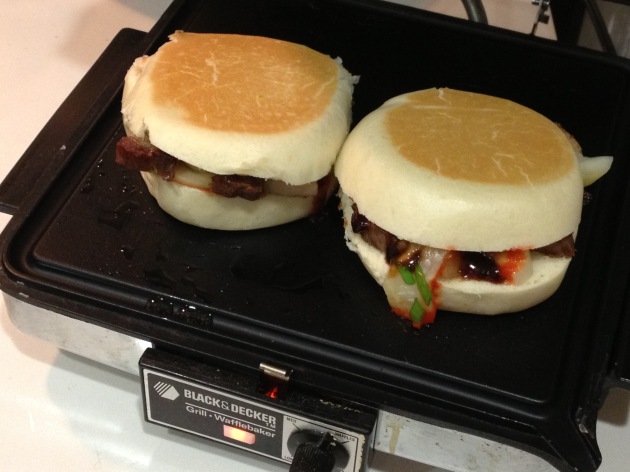 Emeryville, Golden Gate- December 17th 2012 9:09PM
Emeryville, Golden Gate- December 17th 2012 9:09PM
Learning to cook is a lot like going through adolescence. Both are fraught with self consciousness, awkward mistakes, and colored by a deep angst, at the root of which is a desire to belong and matter. There is a tremendous amount of growth and change in a short period of time but the overall positive arc is only visible in retrospect. In the moment all you can taste is the second guessing, feeling out of place, and the uncertainty about who you are and what you can do. The few moments of intense pleasure and accomplishment tend to hit you like a freight train full of unfamiliar yet intoxicating lust.
This is a long-winded way of saying that I remember the hedonistic rush of cooking pork belly for the first time. I had picked up David Chang’s Momofuku cook book and quickly realized that most, if not all, of the recipes enclosed were, how do I put this, out of my league. They required a degree of technical finesse, knife work, and a fully stocked larder of esoteric Asian ingredients that I did not yet possess. Longingly flipping through the glossy pages I found his section on Pork Belly, an ingredient that Anthony Myint had called uniquely hard to overcook in Mission Street Food, another favorite of mine. It seemed like a safe first step.
So I rubbed the belly with sugar and salt as Chang instructed and then realized that I had to leave it in the fridge for at least two but no longer than six hours. I had not anticipated planning my afternoon around the needs of a slab of meat, but I was unemployed and eager to see what the hype was about, so I rearranged my schedule accordingly. This brought back memories of staying logged in to AOL Instant Messenger just hoping that a certain cute girl would log in and say hi.
I roasted the belly as instructed, hot at first and then slow and low. However, I misjudged how small my slab of belly was compared to the quantities that the recipe called for. Unbeknownst to me, Chang was cooking fully 12 pound pork bellies in a restaurant Combi Oven and I was trying to replicate the result with a puny 1 pound square in my apartment oven. I had no idea how surface area affected roasting times, so I had to frantically turn down the temperature to avoid overcooking the meat as the exterior curled and blackened in mere minutes. I narrowly avoided ruining it.
Eager to share my project with Anthony, I crisped the rectangles of belly in a pan and threw them onto white buns with scallions, hoisin, and Sriracha, as instructed. Filled with porcine lust we decided at the last minute to panini press the composed sandwiches, brushing each with rendered lard from the pan. The sandwiches looked chunky and sloppy but tasted forbidden and divine.

Emeryville, Golden Gate- December 11th, 2012 12:02AM
That winter I moved in to my first apartment with Anthony. We had found a spacious ground floor unit next to a community garden on the border of Emeryville and North Oakland. I went in to the experience totally blind. It was the first apartment that I looked at and I met our third house mate Kevin for the first time outside of the apartment on the day we were touring it. Kevin is now one of my best friends and I’ve happily lived in that apartment for coming up on 4 years. Looking back it was an extraordinary stroke of luck that things worked out how they did.
The first meal that the three of us ate together in the apartment was austere and decadent at the same time which sounds more poetic than it was. We each had a single Boudin Blanc sausage that Anthony had procured from a butcher friend, washed down with a crisp Coteaux du Loir from Pascal Janvier. I still had no idea why Kevin and Anthony swirled, sniffed, and slurped their wine the way they did but I was starting to appreciate just how good wine with some terroir behind it could taste. This one cut through the rich, salty pork fat perfectly. Why didn’t more white wine taste like this? I secretly wished we had more sausages.
We drained our glasses quickly and Anthony went to uncork another bottle from the cases he had strewn about by the door. We did not yet have a wine rack to better organize our drinking which has to be the biggest first world problem that I’ve ever written about.
The white slate peninsula separating the kitchen from the living room was still pristine and free of stains. It’s vast expanse beckoned us to throw ambitious dinner parties. The kitchen cabinets were bare too, which left me to gleefully decide on where to store all of my various kitchen gadgets.
We had no furniture yet so at night Anthony and I played intense games of soccer in our vast living room until our feet hurt from running barefoot on the concrete floors. We blasted music and laughed like kids the whole time.
There is a surreal and delicate beauty to a house devoid of clutter. Things will never be as clean, as fresh, and as open to new possibilities as they are in the moment you first arrive.
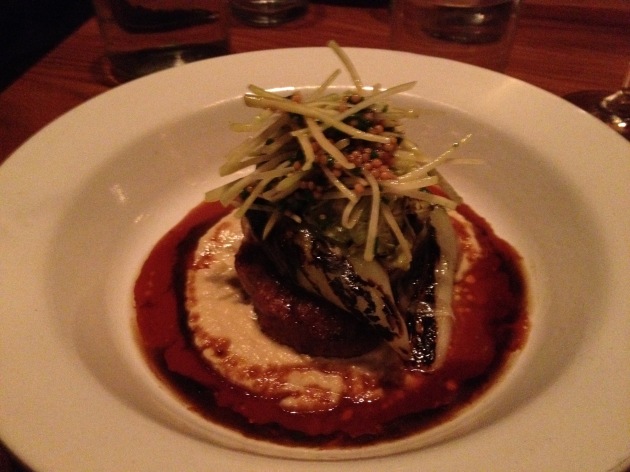
Downtown Oakland- November 24th 2012 9:37PM
Kermit Lynch had brought a small cellars worth of wine to dinner at Plum on Broadway in Oakland. The seams of his canvas tote bag, emblazoned with the company logo, strained under the weight of so many bottles. I had never seen such an open-ended interpretation of a corkage policy but I was not complaining. I just hoped that I could keep up.
I was out of my element. What I had assumed would be a casual dinner catching up with my old friend Anthony, Kermit’s son, quickly evolved into a joyous marathon of wine tasting, pairing, discussion, and debate. The wines outstripped the pace of the many courses we ordered, each glass disappearing in what seemed like seconds to be replaced with another. Festive flutes of sparkling gave way to crisp whites, herbaceous roses, fuller whites, light-hearted Beaujolais, and finally some earthy and brooding reds from Provence and the Southern Rhone. The amount of new terms flying left and right was fascinating but terribly overwhelming for me. My rapidly rising blood alcohol level wasn’t helping me keep all of the new information straight. I desperately wanted a set of Cliff’s Notes to accompany the dinner.
I had so many questions. What was the difference exactly between Chenin and Chinon, Chablis and Petit Chablis, between Brouilly, Reuilly, and Rully? Why were some wines named after a place and some not? Why all of this geological mumbo jumbo about schist, granite, and limestone? How the hell could minerals have a taste? I was drowning in an incomprehensible sea of French geography. The only regions that I felt like I could even pronounce were “All Sauce” and “Long Dock” though I couldn’t have placed them on a map at gunpoint.
Daniel Patterson’s food ended up being a delicious afterthought to my whirlwind induction into the Kermit Lynch wine family.It was the first time I experienced the wine overshadowing dinner. I wouldn’t have remembered anything I ate that night but for the above photo of the pork dish that I managed to capture before Kermit opened up a bottle that was as old as I was, the oeniphile’s equivalent of a Mortal Kombat finishing move. I believe Anthony’s mother Gail asked me some questions about Spanish food and his sister Marley recommended a few restaurants in Mexico City, but my main memory of the evening is feeling like that there was this whole new side of dinner that I desperately had to learn about. It’s funny how much feeling out of place can motivate you. It was clearly going to be a big challenge, which was strangely part of the appeal. It was seductively complicated. The Lynch family had shown me how fun and delicious the end result could be and now I had to go out and earn the knowledge for myself.
I recently embarked on a hair-brained food project halfway between a Michael Pollan novel and an urban homesteader’s fantasy. I made a reuben sandwich entirely from scratch. This means that starting two weeks ahead of dinner time I attempted to make every component of this Jewish deli classic from scratch: the sauerkraut, the pastrami, the bread, and the dressing. I cheated and bought the cheese which is why I can’t sell the movie rights to this story but I can promise you that the resulting sandwich was both delicious and educational. The long road to the ultimate sandwich taught me a lot about the challenges and revelations of doing things the long way and I hope it inspires some of you to try your hand and charcuterie, fermentation, baking, or all of the above!
The sauerkraut was first, requiring a full 2 weeks of fermentation to go from fibrous cabbage to deliciously tangy topping. Key to executing the kraut properly was a large (ie half-gallon or more) vessel and some form of water-sealed airlock. I needed the airlock so that as the salted cabbage fermented it could expel gas without allowing oxygen in. This kept the fermentation anaerobic and allowed the salt to do its chemical magic of creating a happy Kindergarten for the bacteria that I wanted around and a hostile wasteland for the bacteria that I didn’t. In addition to the salt, which was there for safety as well as flavor, I decided to add some delicious seeds: caraway, mustard, coriander, and poppy to be precise. Once the cabbage was salted, seasoned, and packed into my crock I sealed it tight and let it sit on my counter for 2 weeks. Proper fermentation requires a mix of careful attention and benevolent neglect.
Pastrami came next. A week before dinner I biked to a nearby butcher shop and bought 5 pounds of their finest brisket. Brisket, or the pectoral muscle of the cow, is an intense cut that combines dense bands of stringy muscle (grazing is like push ups for cows) with big pockets of fat (they’re cows not crossfitters). Pastrami is brisket that has been cured and then smoked. To make pastrami I first needed to cure the brisket, turning this wedge of stringy meat into savory and delightfully pink corned beef. To do this I created a brine, very salty water that also had a wide array of sweet and savory spices like cinnamon, cloves, allspice, black pepper, nutmeg, and bay leaves. The key ingredient to my corned beef was the pink salt or sodium nitrite, which gave the meat its trademark color and cured taste. After sitting in the brine for a week the corned beef was ready to be smoked. I took it out, rinsed it off, patted it dry, coated it in black pepper and coriander, and let it air dry in my fridge overnight. The next day I smoked the pastrami for 4 hours over hickory wood until it was cooked all the way through but not falling apart. On the big day I would steam the pastrami until tender and then slice into sandwich portions.
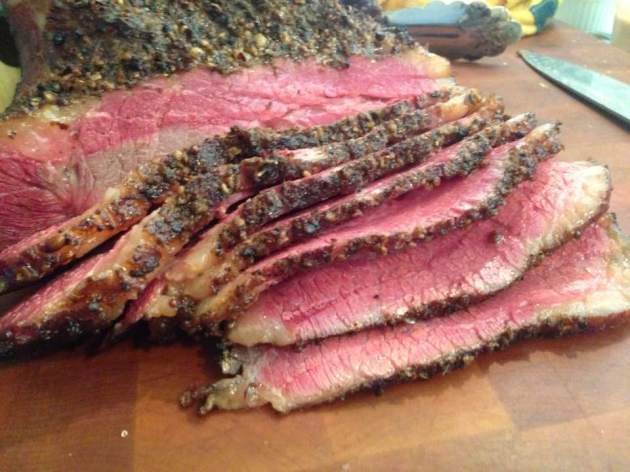
Then I started the bread. The night before dinner I mixed 500g of flour and water (you will want a kitchen scale if you plan to bake a lot, trust me) with a small amount of instant yeast. This preferment, or poolish would help develop the yeast flavor and gluten structure of the break overnight. I added a little bit of my sourdough starter just for fun. On the big day I combined the merrily bubbling preferment with more flour, water, and yeast, and mixed it into dough, a process which feels like a messy science experiment combined with wrestling with an uncooperative toddler. Let’s just say that I am strongly considering buying a stand mixer and dough hook after this last batch. This rebellious ball of gluten was allowed to rise before I divided it, shaped it into loaves, and got ready to bake it in a 475 degree oven. Home bakers should definitely bake their bread in dutch ovens as the hot iron plus the enclosed lidded baking environment creates the perfect mixture of heat and steam for golden brown crisp crust. The crackling crunch speaks for itself!

Russian dressing is a lay up. To make mine I mixed mayo (homemade of course!) with ketchup and added our some minced onion, horseradish, hot sauce, and Worcestershire sauce. Slicing the store-bought Swiss cheese was gleefully easy, for the record.
How was the final sandwich? Was it worth all of the time and effort? It was delicious, memorable, and absolutely worth it. This labor-intensive dinner was an experiential birthday present for my brother-in-law and watching him devour several sandwiches was worth every hour of time that led us to meal time. While I wouldn’t cook this way for casual weeknight meals, this proof of concept was an informative reminder of the time and energy that goes into the foods we eat. It was also an edible exercise in gratitude of sorts. I won’t be taking sandwiches for granted ever again. I left the meal full of pastrami and knowledge and empowered to cook more things from scratch. There are few things that an informed home cook cannot accomplish!
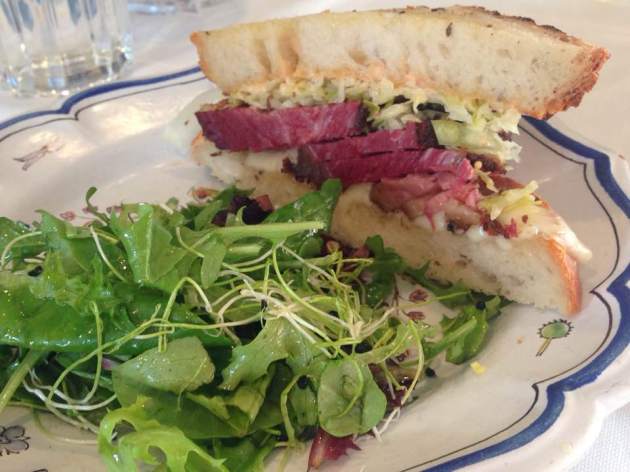
Recommended Reading/References:
“The Art of Fermentation”- Sandor Ellix Katz- An essential encyclopedia for all things fermentation! If this doesn’t inspire you to start fermenting things then your gut flora should look for new lodging.
“Ratio”- Michael Ruhlman- The last food reference that you will ever need that brilliantly distills the craft of cooking down to a few mathematical ratios. His bread and brine sections alone are worth the price of the book.
“Flour, Water, Salt, Yeast”- Ken Forkish- This thorough guide to the craft of bread baking is a godsend. I used his divine white bread with poolish recipe.

El Viso, Madrid- November 21st 2012 9:08PM
After 3 months of passing like ships in the night while I toiled away in the restaurant, I finally had a chance to cook for my aunt, uncle, and two cousins. The idea of cooking for people that I knew and would get to eat with had a shiny new appeal after so many hot and loud lunches and dinners at the restaurant for I had finally learned that restaurant cooking was not a romantic or personal act. It was worlds apart from the self-indulgent dinner parties I had been throwing in Berkeley. The fact that the term “cooking” applied to both could best be thought of as an unfortunate linguistic shortcoming. Restaurant work could be better described as anonymous food assembly while my thoughtful Californian pot swirling peppered with pop culture references deserved another term entirely. I had a lot of pent up energy and dozens of recipes that I wanted to test out on them but we were going out to an art opening and some celebratory tapas later so I had to keep things light and simple. Sometimes restraint is the best appetizer.
To start, I served some delectably well-marbled slices of Joselito jamón iberico de bellota (quite a mouthful!), whose savory ruby flesh met the buttery tiles of cured pork fat in an intersection that cannot be properly described except through expletives. This experience had required no cooking on my end so I accompanied it with a riff on some crostini that I had been tinkering with back in Berkeley. I roasted some fresh piquillo peppers, caramelized some shallots in butter and drizzled them with sherry vinegar and served them atop toasted rounds of baguette with fresh mozzarella cheese, and a verdant chiffonade of basil to show off my newly found knife skills. It was a wonderfully enthusiastic California-Mediterranean mash up that is probably selling for $18 a plate somewhere in Rockridge right now. Having had Paella for lunch and jamón at dinner, we then went out for some Rioja and garlic prawns as a nightcap. It was a very Spanish day and a wonderful conclusion to my time in Madrid. Sometimes the best way to mark a life transition is not with the right words but with the right meal.
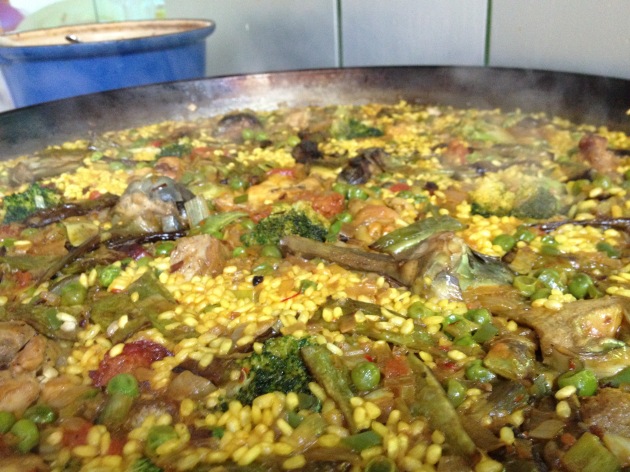
El Viso, Madrid- November 21st, 2012 2:56PM
A cook is only as good as their repertoire. That is why I couldn’t leave Spain without at least trying to learn how to make Paella. I had long been cautious of beloved and complicated rice dishes like paella and risotto because they seemed to be a minefield of potential mistakes for an enthusiastic amateur like me. One wrong move and grandmothers everywhere would be grimacing in disgust and brandishing thick rolling pins. To even attempt Paella I had to remind myself that I was in Spain precisely because it was so far outside of my comfort zone.
My instructor was was Arí, my aunt and uncles’ live-in maid, cook, and housekeeper. A jovial woman from the Dominican Republic, Arí had a veritable greatest hits record of recipes under her belt that she regularly cooked for dinner at the house. I never got to eat these dinners, being thoroughly absorbed in staff meal at La Manduca, but would gleefully learn about them the next morning through the leftovers stored in green Ikea tupperware in the fridge. My metabolism did not work with the Iberian breakfast of light carbs, fruit, and espresso and so I would regularly eat savory leftovers for breakfast instead. My cousins found this, along with my Youtube obsession, to be some of my more puzzling eccentricities.
Recipes, as I had learned at La Manduca, were the universal currency amongst cooks so I offered to trade Arí my recipe for Mexican barbacoa for her recipe for Spanish Paella. She agreed and began showing me the ropes on one of my last afternoons in Madrid.
The keys that Ari taught me were deeply browning the meat (chicken and chorizo in this case) separately and then cooking the vegetables in this flavorful jacuzzi of rendered animal fat. Much like a wok-tossed stir fry, the various proteins and vegetables were cooked individually at first and only recombined carefully at the end. Once the rice was added the whole thing had to be watched like a hawk as stock was added, keeping an eye on the heat so it would absorb the flavorful liquid but not burn or turn mushy. It was a textural tightrope that had to be walked with extreme care and precision.
As in many rice cultures around the world, there was an art to delicately browning of the rice so it stuck, but just slightly, to the bottom of the pan. This batch proved too slick and fatty to create proper crispy bits, which my aunt Belén keenly observed with a touch of disappointment in her voice as we ate lunch. While it was certainly not as good as the Valencian Paellas that Jordí made for staff meal at La Manduca, I was very happy with how ours turned out and couldn’t wait to have it for breakfast the next morning.
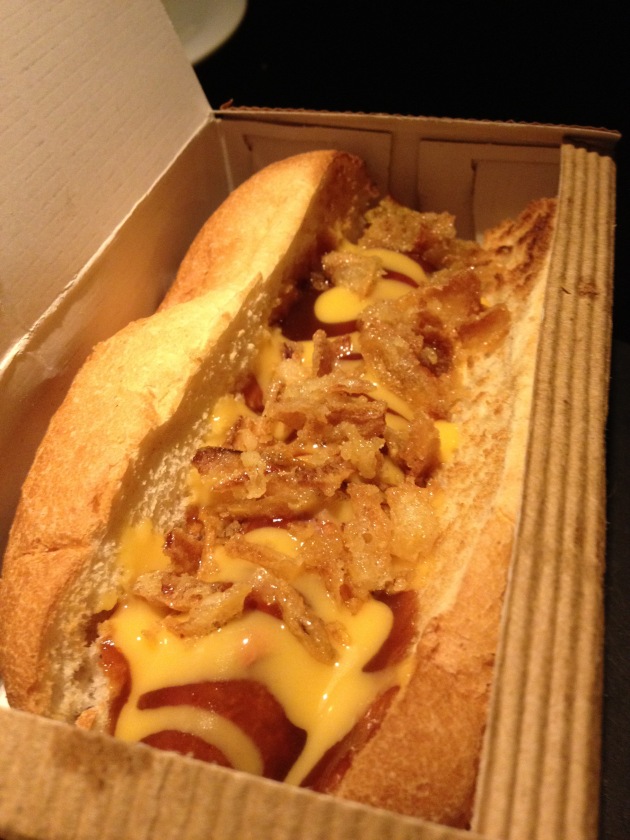
Madrid- November 20th 2012 9:46PM
After 3 months in Spain I thought I knew a thing or two about cooking and so during the lulls between rushes I would day dream about the type of food I would cook when I owned a restaurant. These fantasies inevitably involved appropriating things that I had recently learned at La Manduca and applying them to American junk food. I would turn the “rabo de toro” into oxtail taquitos, the croquetas into jamón ibérico grilled cheeses, and the crispy torrija dessert into a bruleéd version of French toast that I would cleverly name “Cinnamon Toast Crunch.” I even had a name for my American Tapas concept restaurant: “Snack Bar” and a name for its eventual Mexican sister restaurant: “Salsa Bar.” My high-end munchies food would surely take the nation by storm. At 22 I had no idea just how little I knew.
When my apprenticeship came to an end I had a few days left in Madrid before I had to fly home for Thanksgiving so I decided to try eating at a few other restaurants as some last research. I identified “La Gabinoteca” as a must visit immediately. Anthony Bourdain had eaten there during an Iberian episode of “No Reservations” and the inspired gastropub fare looked like exactly the type of food I would serve at Snack Bar. Eager to indulge and hopefully poach some recipes I texted my friend Scott and locked down a reservation for the two of us. We sat down, ordered a bottle of the house Rioja and plowed our way through their menu
Their whimsical take on a hot dog knocked me on my ass right out of the gate. The Bourdain-approved “perro caliente cón pedigrí” or a “hot dog with a pedigree” was a tender Galician veal sausage topped with homemade ketchup and cheese sauce and delightfully crunchy fried onions. With iPhones out and eyes wide with glee we devoured this first course.
The dish that came to the table next was a blue tin Rice Krispies box that, when opened released a blue cloud and exposed four perfect cubes of tender smoked beef throat, perfectly cooked, and topped with a single pickled onion petal. Willy Wonka had evidently learned how to barbecue.
The meal concluded with a dessert that you built yourself, constructing an artful brownie sundae you were encouraged to photograph and send to the restaurant for the chance to win a prize. We were buzzed of the Rioja by this point and relished the chance to play with food and take more pictures.
I had found my culinary muse. Each dish displayed an effortless combination of fun, humor, and playfulness that was fully backed of by mastery of cuisine and ingredients. The straight forward meat and vegetables that I had been cooking at La Manduca seemed stern and boring in comparison, like listening to Gregorian chanting after hearing Jimi Hendrix for the first time. If food was a language then I had just discovered satire.
Justicia, Madrid- October 24th 2012 8:51PM
Family meal was an important ritual at La Manduca de Azagra, the Navarran restaurant on Calle Sagasta where I apprenticed for 3 months during the fall of 2012. It was the calm before the storm. In the last minutes before service the staff would gather in the downstairs dining room and share in a simple but hearty meal, fuel for our frantic efforts to survive the upcoming service. These were the final moments of being people before we put on our jackets, climbed the stairs to the kitchen, and became cooks again.
For me, the nervous American outsider who everyone called “Ray” and eagerly absorbed any recipe like a sponge; family meal was also a gastronomic tour of Spain. Family meal was all about simple classics, so each cook prepared a beloved specialty from their unique corner of the country. Jordí, the scrawny Valencian with ambitions to be a model made a different Paella every Tuesday. Raquel, my chain-smoking Navarran mentor, braised several rabbits in cognac and served them over boiled potatoes. Victor made Cocido, the savory Madrileño one pot wonder of beef shin, chorizo, morcilla, chicken, chickpeas, potatoes, and cabbage. One memorable day Luis, who had spent time in Barcelona, had made Cocas, a traditional Catalan flatbread with caramelized vegetables.
During the meal, Sebastían, the grill cook, told me that in a week I would be making staff meal. I knew then I had to make them tacos. It was a nerve-wracking honor for me to suddenly bear the torch for my home state and favorite cuisine so far from home, but I was determined to impress the team with my cooking. Sebastían volunteered to order most of my ingredients directly to the restaurant but I decided to visit the American specialty store (Taste of America) on my day off to find the perfect hot sauce. Everything had to be right. This was my one shot. On the big day I realized too late that the tortillas from Corte Ingles were bland and dry so my refried beans would have to be extra good to compensate. As I sweated off the aromatics for the beans while pitting avocados for guacamole I overheard “Stronger” by Kelly Clarkson playing on the radio and her synth-pop confidence convinced me that I could nail this meal.
With the exception of the tortillas, which were left nibbled and cracked on the plate, everyone devoured their meals and I got a few compliments on the strange “avocado sauce” that accompanied the tacos. I had picked up a few Reese’s Peanut Butter cups as an impulse buy at “Taste of America” and handed them out after the meal as dessert. They proved to be more popular than the tacos but required a lengthy explanation of what peanut butter was. When I finally left La Manduca before Thanksgiving, my parting gifts to the staff were several bottles of Valentina hot sauce and some packages of Reese’s, to help keep family meals interesting.
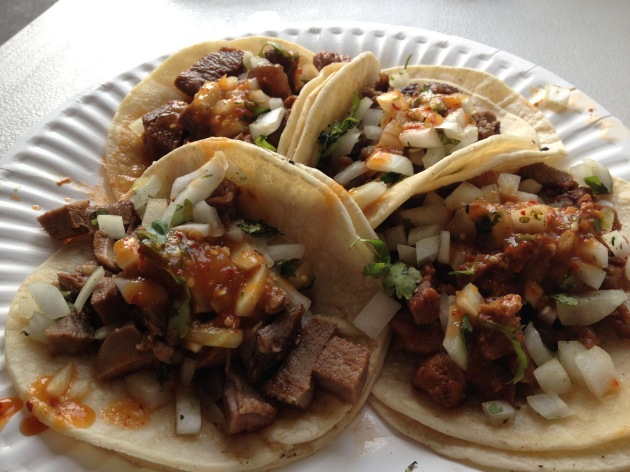
Mount Baker, Seattle – August 13th 2012 6:50PM
I was sitting in a school bus that had been converted into a taco stand, eating tacos de lengua, telling myself that I ordered them because they were authentically Mexican and not because tongue grossed my girlfriend Gena out, which it did. Gena’s friend Kristen had insisted that this spot,”Taco Bus,” was the best taco place in all of Seattle. I wasn’t sure how accurate this was but had to admit that so far I had been very impressed and seduced by the food in this city. Kristen’s carefully curated tour of her hometown had included outrageously filing Caribbean sandwiches at Paseo, gourmet enchiladas at Little Water Cantina (owned by a Kenyon alum, she noted), and now this quirky gem. Won over by the seemingly endless restaurants, microbreweries, potent coffee, and epic vistas, Seattle was looking like a city that I could move to happily. I was growing increasingly fixated with the romantic idea of starting a new life here.
This was during a stage in my life when visiting new cities felt like dating while dating was starting to feel like being lost in a foreign city. Gena and I were two years apart and ever since graduation this gap had started to feel more pronounced. As I was entertaining the idea of moving to one of six different places and starting one of six different career paths she was still on the railroad track progression of college, now approaching the “go abroad” stop and then onward from there to Junior and Senior year. The timing didn’t lineup but more importantly, outside of the nurturing greenhouse of intimacy that was a small college we were running into the very real obstacles of adulthood. Convinced that a road trip to see our friends Jack and Kristen in Seattle would give us the quality time together we needed to make things right, we packed our things into Gena’s moms Honda and headed North up highway 5. They say that traveling with someone is the best way to test your relationship and looking back I can now say that this is true. We went to Seattle and then Spain together over the course of 2 months and by the time we got to Madrid the fact that she wouldn’t eat shrimp or ham was insufferable to me and there was no coming back from that. These were the last tacos that we had together.
Intro: If there is one thing the internet does not need it’s more photos of food. We live in the age of the Instagram meal, where it didn’t exist unless your friends liked it before you tasted it. My phone epitomizes this trend, containing more photos of food and wine than human beings. Based on my photos, a stranger would be forgiven for thinking I was an antisocial and obese recluse. Yet as I was going through my phone recently in an effort to delete duplicates and free up space it struck me how much growth and change are encapsulated by the layers of food photos. Having just finished reading “All the Light We Cannot See” I was captivated by the idea that the sum of a string of food photos and the negative space between them could be much more meaningful than simply reciting meals that I have experienced. More than just “All The Food You Cannot Eat,” these photographic tree rings are in fact another way to tell the story of my life. The problem then, it occurred to me, is not the number of food photos on the internet but the lack of stories. A photo of food with no context conveys little other than ones appetite for narcissism or trend savviness, but put in proper context it can speak volumes. So I’m starting a project (Plate & Date) where I will regularly share a food photo and a short (250-500 word) essay that explains whatever moment, lesson, or story that this photo trawls up. I’m going chronologically here so we begin our journey four years ago…

Downtown Berkeley- July 27th, 2012 1:57 AM
I almost didn’t share this photo out of embarrassment. The quality is abysmal and I have dozens of prettier photos of late night tacos, which will certainly become a leitmotif of this series. Then I realized that the whole point of this exercise is candor and honesty, not overthinking or over-editing my past. So, if I’m being honest, this photo pretty accurately captures how I was four years ago at two in the morning outside of Thalassa on Shattuck: blurry and focused only on tacos. I had just graduated from Kenyon College and was riding high on my success as a budding professional cook. My business “Last Call Food Cart” had made waves outside of frat parties and alumni events and had convinced me that this was where my future was going. Home at last for the summer, I was in a celebratory mood. This was when going to bars was still new and the thrill of being carded and then served made the gin taste sweeter and the IPA less bitter. My high school friends and I had eagerly packed in to a booth and had a passionate argument about approximately nothing for an hour before being ushered outside as the lights came on at last call.
There are few things as beautiful and self-explanatory as the harmony between the murmur of a bar trickling out and the sizzle of a curbside griddle. The stand was called “Powered by Pork,” and the owner Justin was slinging Asian fusion mini-tacos to the drunken hordes staggering back to their lives. The pork shoulder was tender, the mint bright, and the Hoisin just salty enough to encourage my body to hang on to some water for the morning. Later, sobering up and gripped with last minute doubts about traveling to Spain to start a cooking apprenticeship, I Facebook messaged Justin for advice. His response was: “keep your head down, your mouth shut, and work harder than everyone else around you.”